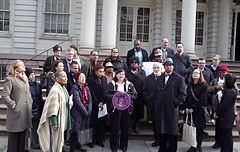Members of the city council are calling on the New York City Housing Authority to submit to a standardized public review process as it moves ahead with its plan to lease parking lots and playgrounds to private developers. But today the agency rejected that idea, fueling accusations that it’s moving too quickly and steaming-rolling right over tenants.
At a City Council Committee on Public Housing hearing this morning, tenant-association presidents from at least four of the eight sites that have been selected for development expressed concerns about the plan — and in the case of Smith Houses, Meltzer Houses and Baruch Houses, outright rejected it.
Aixa Torres, president of the Smith Houses tenant association, announced that residents of the Lower East Side complex were “absolutely opposed” to the plan. “We have survived 9/11, earthquakes, and two hurricanes,” she said, indicating that Smith residents had been through enough.
As expected, the city council committee called on the housing authority to submit to the Uniform Land Use Review Procedure (ULURP) that gives the City Planning Commission, City Council, and Mayor the ability to approve or disapprove the plan. But John Rhea, the chairman of the housing authority, argued the agency was under no obligation to do so, insisting that the procedure would significantly slow the infill process and delay a plan to issue a Request for Proposal seeking potential developers at the end of this month.
At the heart of the discussion was whether or not the land in question is public. “My understanding is that when you build on public land, you have to go through ULURP,” said council member Margaret Chin. But Mr. Rhea insisted that according to the City’s charter, the land is not public, since the housing authority, which owns it, is legally a public benefit corporation.
Council member Rosie Mendez insisted the ULURP process would force the agency to engage in a more “meaningful” process with public housing residents.
Tenant association presidents pushed for more time and opportunity to weigh in on the infill plan. “This baby ain’t gonna be birthed unless they sit down with us blow for blow for blow for blow,” said Crystal Glover of the Washington Houses in East Harlem, at a press conference on the steps of City Hall before the hearing.
Others tenant-association presidents demanded quick access to funds that would allow them to hire third-party experts who, among other things, could determine whether the structural integrity of existing buildings would tolerate adjacent construction. “This process should not have even begun without every resident association having the proper technical and legal support in place,” said council member Melissa Mark-Viverito.
Though the housing authority has held informational meetings lasting several hours at each of the proposed sites, criticism has been raised about the effectiveness of flyers promoting the meetings. Holding up a flyer that had been distributed at Meltzer Towers, Ms. Mendez said the photo of the property could lead residents to believe the development project would replace Meltzer itself.
Mr. Rhea responded by pointing to the fact that full information is posted online. “That’s not good enough,” Ms. Mendez returned. “Not every one of our residents is going online.” Meltzer, in particular, is a senior citizen development.
Others noted that the $60 million that the public housing authority hopes to raise from the plan is dwarfed by the $70 million it pays to the police department every year for “special police services.” Several council members and tenant associations asked Mr. Rhea to address the possibility of ending that requirement.
Damaris Reyes, a resident of Baruch Houses and executive director of community housing group Good Old Lower East Side, asked in her testimony, “Is this sum worth the sacrifice? We know that NYCHA pays the NYPD a double tax that no other New York City resident is asked to pay.” GOLES has joined with three of the lower Manhattan houses to outright oppose the infill plan.
The housing authority still plans to issue a Request For Proposal at the end of this month. Meanwhile Fred Harris, the agency’s Executive Vice President for Development, will give presentations to interested community boards, including Community Board 3, which has not officially taken a hard stance on the proposal either way.




